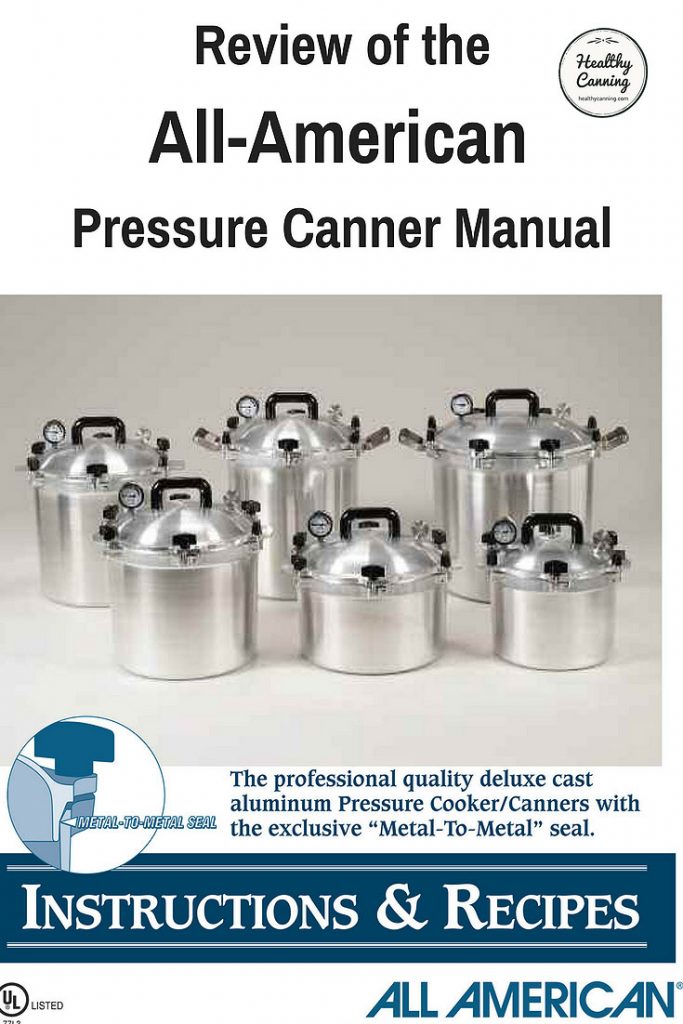Where to get the All-American pressure canner manual
The most recent electronic version (as of June 2020) of the All American Pressure Cooker / Canner product manual that we know of is 2014. You can verify the date of the manual by looking on the parts price list page in the manual. In the 2014 edition, on page 51, the date given is September 2014.
The manual is here for download: All-American Pressure Canner Manual 2014
See also: Discussion of All American Pressure Cooker / Canners
Problems with previous editions
Recent previous editions of the All-American manual include 2008 and 2004. Much of the canning advice in previous editions was very out of step with USDA recommendations. The processing times and pressures advised are very different and we just have no way of knowing what processing authority developed and tested those times, if at all.
Issues with the most recent edition
By 2014, All-American had done a major revision of the manual, and synced all its canning recipes with the USDA. They also updated the recommended venting time from 7 minutes to 10 minutes to match USDA standards. In fact, all the canning directions now in the 2014 version are a subset of recipes straight from the USDA Complete Guide, 2009. The only changes they made were dropping processing options / times for boiling-water bath on some products, and dial gauge processing times on others. We don’t see any issue with those recipes. You are fine to use them; we went through them line by line comparing them with the USDA Complete Guide and in most instances, even the exact wording has been copied.
However, two things in the Q & A section that follow the recipes would concern many people.
One is advice about recanning. Recanning is the practice of buying foods in very large cans (for instance, catering size, such as you could buy at Costco, etc.), and then at home, opening those large cans, transferring their contents to smaller jars, and then recanning them. The USDA recommends against recanning.
The National Center specifically notes that you can’t just use processing times that were developed for fresh produce being canned: “The way the heat is distributed throughout the jar during canning will be very different if you start with already canned/cooked food than with fresh. Excessively softened foods will pack more tightly into a jar, or arrange themselves differently and the process time recommended for fresh foods will not be enough for the already canned foods.”
The All-American manual, however, contradicts the USDA and the National Center and gives it an “okay.”
Q. When canned or frozen fruits are bought in large containers, is it possible to can them in smaller containers?
A. Any canned or frozen fruit may be heated through, packed, and processed the same length of time as recommended for freshly prepared food. This canned food may be of lower quality than if it had been canned when fresh. (2014 Edition, page 44)
The second concerning point is advice about processing times for jars that failed to seal. The USDA recommendation is that if you want to try reprocessing the jar of food that didn’t seal (as opposed to just sticking it in the fridge for immediate consumption), the original full processing time must be used.
The All-American manual contradicts this and offers some very vague guidance instead.
Q. If a jar does not seal and must be reprocessed, does it have to be processed the full length of time
A. Just what should be done with the unsealed jar will depend upon the cause. If the cap or lid is at fault and the product is a fruit, simply replace the cap or lid with new one and process until product reaches boiling point. If it is a vegetable or meat, it should be reprocessed approximately one-fourth to one-third the regular processing period. If the jar is defective, any product would require repacking. It is doubtful if this will be profitable since the reprocessing would need to be of approximately the same length as a normal period for that particular food. Few foods will stand up under such treatment. (2014 Edition, page 44)
It’s really too bad about those two points, because otherwise, the 2014 edition of their manual would have been one that people could have recommended with little cause for hesitation.
Summary
For that reason, Healthy Canning recommends that you use the manual for basic operating instructions only. For all specific canning recipes and advice, including venting, altitude adjustments, and processing times, we recommend that you follow directions from the USDA, the National Center, the University Extension System or sources such as Ball or Bernardin.

